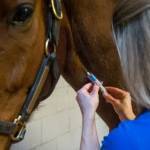Lameness in Horses: Lyme Disease a Culprit?

According to the most up-to-date consensus statement, ticks harboring Borrelia burgdorferi, one of the bacteria that causes Lyme disease, continue to spread across the East and West Coasts of the United States, infecting horses and causing clinical disease. While many horse owners think that fluctuating lameness, decreased athleticism, and behavioral changes in conjunction with a positive test result proves their horse has Lyme disease, researchers suggest otherwise*.
“Some horses with Lyme disease develop lameness, but the three most common clinical syndromes associated with Lyme disease include the neurological form called neuroborreliosis, the ocular form that causes uveitis, and a form affecting the skin referred to as cutaneous pseudolymphoma,” explained Laura Petroski-Rose, B.V.M.S., a Kentucky Equine Research staff veterinarian.
In fact, the researchers wrote, “The association of B. burgdorferi infection with stiffness and lameness in horses is not well documented and there is no evidence of the infection causing laminitis.”
Even in areas endemic for Lyme disease, lameness due to Lyme doesn’t seem to be of concern to experts. If it isn’t Lyme, what else could be causing lameness?
“Osteoarthritis in the joints of the lower limbs remains a leading cause of stiffness and lameness in horses,” reminded Petroski-Rose. “Additional causes of chronic lameness could include laminitis, soft-tissue injuries affecting ligaments and tendons, cellulitis, osteochondritis dissecans lesions, certain types of fractures, to name only a few.”
Any horse with lameness should be examined by a veterinarian to identify the source and, if possible, the underlying cause. To help protect horses and their joints from osteoarthritis, considering offering joint supplements prior to any joint trauma that can be incurred through routine exercise and training.
“Kentucky Equine Research offers several joint supplements that help protect joints prior to insult and slow the progression of disease in animals already diagnosed with osteoarthritis,” Petroski-Rose said.
*Divers, T.J., R.B. Gardner, and J.E. Madigan. 2018. Borrelia burgdorferi infection and Lyme disease in North American horses: A consensus statement. Journal of Veterinary Internal Medicine. 32(2):617-632.








